Here is a recipe requested by a reader in Nagi’s post ‘Request a Recipe!’ – Japanese Vegetarian Curry. The consistency is just like the store-bought Japanese curry roux. It’s nothing like Indian curry or any other curries in the world!
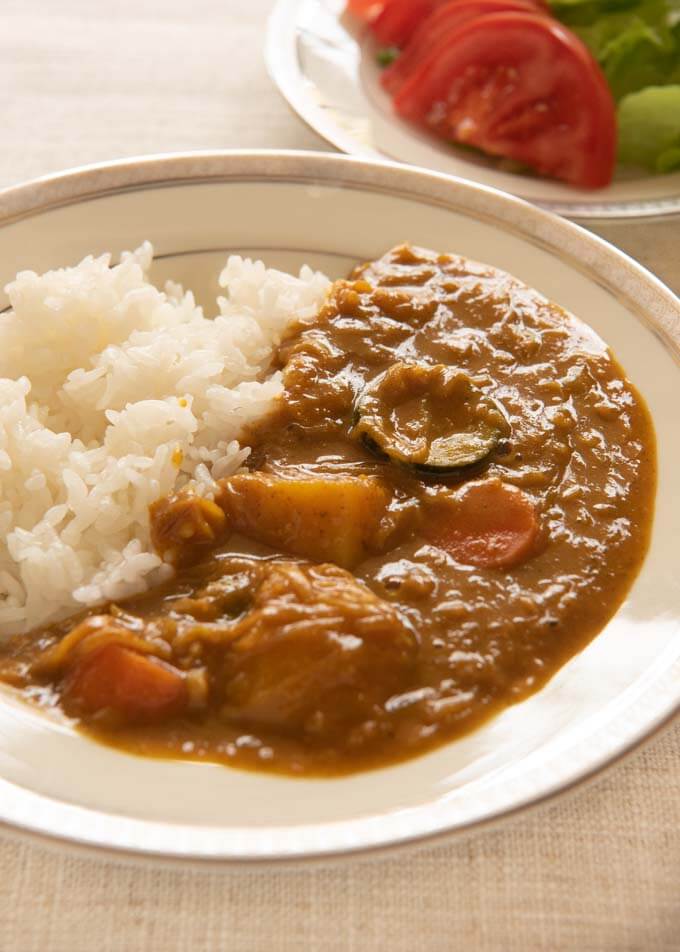
It took me a while to complete it but I now have a home-made Japanese vegetarian curry. I am still working on other Japanese recipes requested by Nagi’s blog readers through her post ‘Request a Recipe!’.
I have only posted few recipes from the list of Japanese dish requests so far. There is a big gap between the last one, Simple Kimchi Recipe and today’s Japanese Vegetarian Curry, but I have not forgotten about the other requests.
When I was living in Japan, there was no such thing as vegetarian curry roux available from the store-bought curry roux brands such as House and S&B. But the times have changed and these brands now sell curry roux that is 100% vegetarian. Here is one of the vegetarian curry packs.
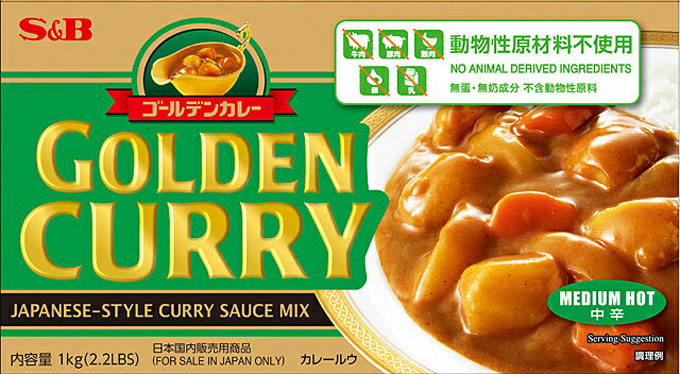
But you can also make it at home.
Home-made Vegetarian Curry Base
The main ingredient of the curry base is a large amount of thinly sliced onion. The onion slices are sautéed with grated ginger and garlic for about 10 minutes until they become very soft and a dark creamy colour.
Added to the onion slices are flour, curry powder, chilli powder and tomato paste. That’s about it but the addition of flour makes the Japanese-style curry unique – giving the béchamel-like consistency of curry sauce.
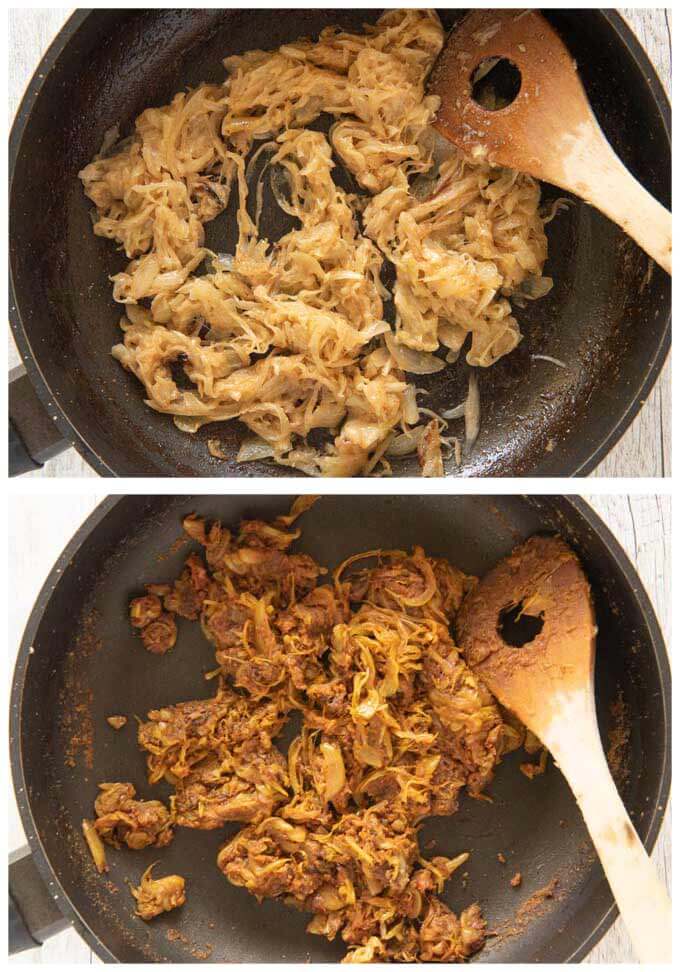
To complete the Japanese curry, other ingredients that add to the flavour of this curry, such as wine, soup stock, etc. will be added later. I separated these ingredients from the curry base because you can make it a vegetarian curry like today’s recipe or a meat curry at this point.
Vegetable Curry or Meat Curry
After the curry base is done, add chopped vegetables to it and sauté before adding liquids and other ingredients to cook the vegetables in. This will make a vegetarian curry.
If you would like a meat curry instead, say chicken curry, brown chicken pieces (large bite size, bone in or out, skin on or off) in a separate frying pan and transfer them to the curry base.
Finishing the Curry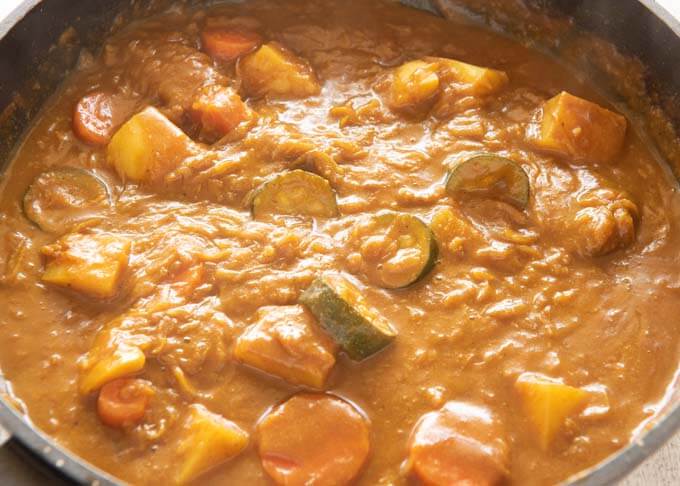
Add wine, then water, vegetable stock powder, salt, grated apple and tamarind to the pot. Then cook for about 15 minutes.
You will need to stir occasionally so that the curry does not stick to the bottom of the pan.
When the consistency of the curry sauce becomes like béchamel sauce, it is ready.
Vegetables to go with Vegetable Curry
Typical vegetables are potato, carrot and something green to give great colour combinations. I used zucchini but you can use green capsicum or even yellow capsicum. Okra is also good and so is eggplant.
When cutting vegetables, think about the time taken to cook the vegetables through. For example, I cut potatoes larger than carrots as carrot takes longer to cook if they are same sizes. Zucchini pieces are added to the curry later than potatoes and carrots.
Okra and eggplants will need to be added later, too.
Spiciness of Curry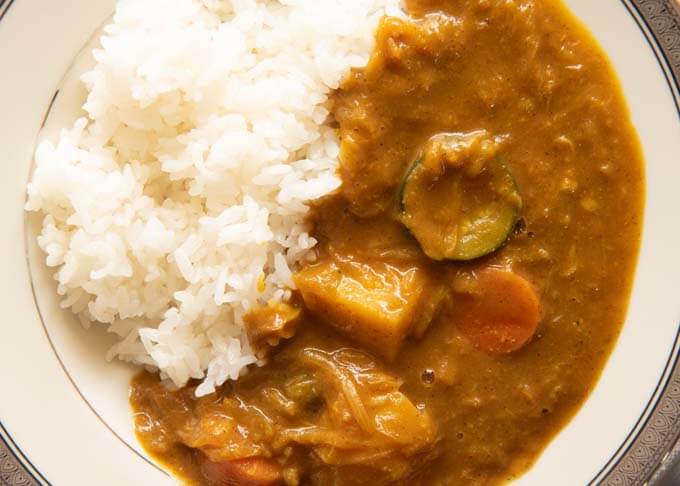
The heat of the curry comes from the chilli powder. Use mild chilli powder if you are not good with the heat. I saw mild, medium-hot and hot chilli powders sold at the shop. You can also adjust the amount of chilli powder to control the heat.
I used hot chili powder and the heat is like the store-bought hot Japanese curry roux.
This is an easy vegetable curry recipe. Japanese curry recipes require minimum spices as Japanese people are not used to using a lot of herbs and spices commonly used in other curries.
I did not include it in my recipe, but you could add some honey to it and make the curry just like the House Vermont Curry that I mentioned in Katsu Curry (Japanese Curry with Chicken Cutlet).
The curry will keep in the fridge for several days. Reheating every day will keep it better. You can freeze the vegetarian curry but the texture of potato and some other vegetables will be slightly deteriorated.
Yumiko![]()
PS: I added a new section ‘MEAL IDEAS’ below the recipe card. It gives you a list of dishes that I have already posted and the new recipe in this post that can make up a complete meal. I hope it is of help to you!
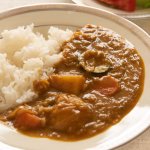
Japanese Vegetarian Curry is a recipe requested by a reader. The consistency is just like the store-bought Japanese curry roux. It’s nothing like Indian curry or any other curries in the world!
- 1 potato (200g / 7.1oz), halved and cut into bite size pieces (about 12 pieces in total)
- 100g/3.5oz carrot , cut into 2cm / ¾" thick discs (note 1)
- 100g/3.5oz Zucchini , cut into 2cm / ¾" thick discs
- 100ml/3.4oz dry white wine
- 400ml/0.8pt water (note 2)
- 2 tsp vegetable stock powder (note 2)
- 1 tsp salt
- 1 tbsp sugar
- 1 sweet red apple , grated (optional)
- 1 tsp tamarind
- 2 tbsp oil (note 3)
- 30g/1.1oz butter (note 3)
- 2 onions (450g / 1lb), very thinly sliced
- 25g/0.9oz ginger , grated
- 2 cloves garlic , grated
- 2⅓ tbsp flour
- 2 tbsp curry powder
- ½ - 1 tsp red chilli powder (note 4)
- 2½ tbsp tomato paste
-
Put oil and butter in a large frying pan over medium high heat and melt the butter.
-
Add ginger, garlic and onion to the frying pan and sauté for about 10 minutes until the onion becomes yellowish and very soft with some browning around the edge (note 5).
-
Reduce the heat to medium and sprinkle flour over the onion. Sauté to cook flour for 1 minute.
-
Add the remaining Curry Base ingredients and cook for another 1 minute, mixing the ingredients well.
-
Add potato and carrot to the curry base and cook for a couple of minutes.
-
Add wine, turn the heat up and mix well.1. When it starts boiling, add the remaining ingredients and mix.
-
Place a lid on and cook for about 7 minutes, then add zucchini. Cook further 8 minutes or so with a lid on until the vegetables are cooked through and the curry becomes a béchamel sauce consistency (note 6). Mix the curry occasionally to ensure that it does not stick to the bottom.
-
Serve with hot rice (not in ingredients).
1. If the carrot is very thick, halve it vertically, then cut into half discs.
The size of the carrot pieces should be slightly smaller than the potatoes so that they will cook in the same time.
2. I used Vegeta stock powder. Instead of 400ml water and stock powder, you can use vegetable stock, preferably salt reduced. In this case, you may need to adjust the amount of salt to add as the stock already contains salt.
3. If you cannot have butter, use 4 tablespoons of grapeseed oil or palm oil instead of oil and butter.
4. If you like spicy food, you may want to increase the hot chilli powder to ½ teaspoon. This will make the curry pretty spicy. You can also reduce the amount of chilli powder or use mild chilli powder instead, if you prefer milder curry.
5. If the onions are sticking to the frying pan, add a small amount of oil.
6. If the curry is still too watery, remove the lid and cook to condense the sauce.
7. The curry can keep in the fridge for several days. Reheating every day will keep it better. You can freeze the vegetarian curry but the texture of potato and some other vegetables will be slightly deteriorated.
8. In addition to examining ingredients of store-bought Japanese curry roux, I referenced the recipe by Masaru Doi in the Japanese magazine called Japanese Homemade Recipe.
9. Nutrition per serving, assuming 6 servings. Rice is not included.
serving: 215g calories: 176kcal fat: 7.2g (11%) saturated fat: 1.6g (8%) polyunsaturated fat: 1g monounsaturated fat: 4.1g cholesterol: 5.2mg (2%) sodium: 428mg (18%) potassium: 418mg (12%) carbohydrates: 23g (8%) dietary fibre: 4g (16%) sugar: 9.2g protein: 2.5g vitamin a: 30% vitamin c: 26% calcium: 3.1% iron: 7.3 %
Meal Ideas
A typical Japanese meal consists of a main dish, a couple of side dishes, a soup and rice. I try to come up with a combination of dishes with a variety of flavours, colours, textures and make-ahead dishes.
Since the main dish is vegetarian, I will make today’s Meal Idea 100% vegetarian. Instead of Pickled Turnip, simple fresh salad such as Daikon Salad (vegetarian version) would work, too. Use konbu dashi for the soup. I picked clear soup instead of miso soup as I think clear soup cleanses the palate after having curry.
- Main: Home-made Japanese Vegetarian Curry – today’s recipe, make ahead
- Side dish 1: Pickled Turnip (Senmai-zuke) – make ahead
- Side dish 2: Gomoku-mame (Simmered Soybeans with Vegetables) – make ahead
- Soup: Dried Tofu Skin Soup – Clear Soup
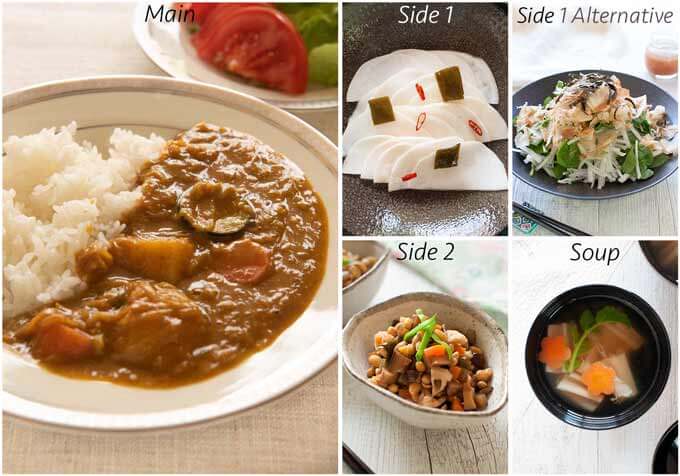
What a delicious recipe! I am looking forward to making this to go with the chicken cutlet per your katsu curry dish. Thank you so much for sharing your knowledge. I’m discovering all sorts of wonderful new-to-me foods on your site.
Hi Kathy, you are most welcome. I hope you will like new dishes that you try from my collection!
I had a Japanese friend when I was young and she always made us curry, it’s one of my fondest food memories. This amazing recipe took me right back there!! I make it with tofu katsu and it’s in regular rotation at our house. Thank you so much for this delicious recipe!
Hi Lesley, thank for adding this recipe to your home-cooking repertoire. Wishing you a Happy New Year!